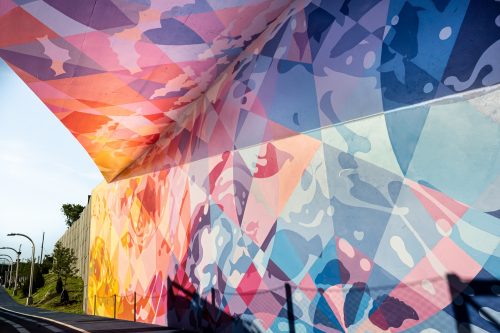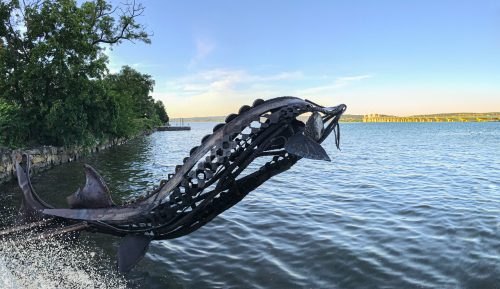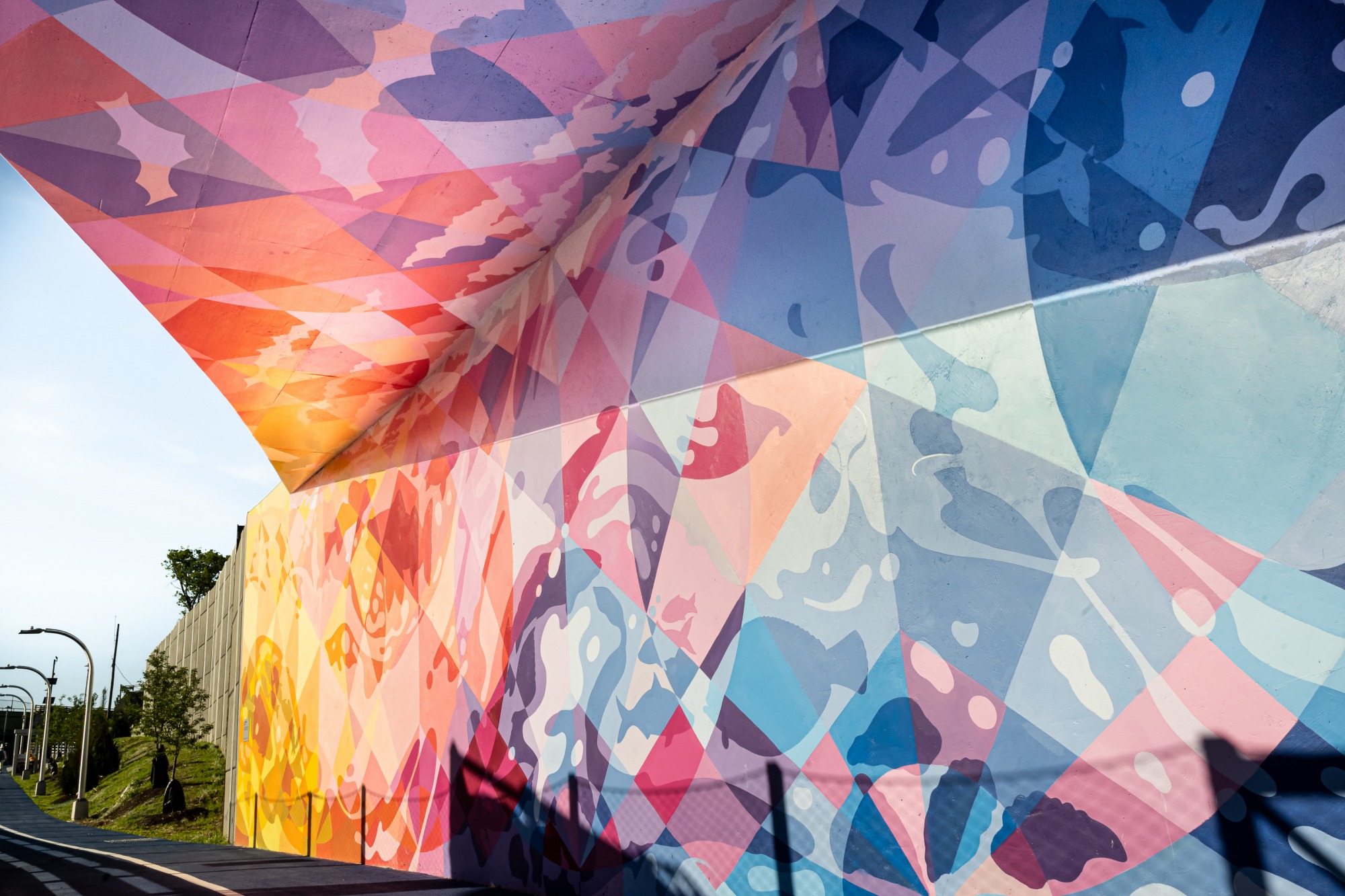Reflections on a Bridge: a Conversation

Chris Soria (photo credit: Margaret Fox) LOCATION 4
On June 15, Governor Andrew Cuomo cut the ribbon on the shared use path of the Gov. Mario M. Cuomo Bridge, officially welcoming pedestrians and cyclists to a 3.6 mile, bright blue, trailway across the Hudson River. The opening of the path was a capstone to the bridge itself – the biggest infrastructure project in the nation. The inclusion of 10 works of art by New York State artists was led by ArtsWestchester. Now that the path is open to the public, CEO Janet Langsam and Deputy Director Kathleen Reckling, reflect on some moments from the two-year collaborative process.
Janet Langsam: Given the Bridge’s enormity and its importance as a gateway to the Hudson Valley, ArtsWestchester was proud and humbled to have played a tiny part this project.
Kathleen Reckling: Yes, it all started when we decided to honor the bridge as a work of art at our gala in 2017. I think the entire board was awed by the grace and beauty of the design.
JL: I suppose it was an easy leap from there for us to suggest to the powers that be that this public, iconic bridge should have some works of art. Fortunately, the idea resonated with Project Director Jamey Barbas and her team at the New York Thruway Authority. In fact, as an architect, Director of Public Outreach George Paschalis is someone close to the idea of creative placemaking, which is a concept we espouse.
KR: I think this was one of those moments when we said to each other: “Be careful what you wish for.” Working in partnership with the New York State Thruway Authority, and in collaboration with the Arts Council of Rockland, ArtsWestchester became the administering agency for the selection and fabrication of 10 major works of public art for the termini of the path: five sculptures, four bike racks and one mural.
JL: That one mural was a challenge. And it became quite a statement, covering 4,000 square feet. It wasn’t a simple mural…it was a mural in a 75-foot-long tunnel that was painted on three sides so you can really feel enclosed in color. Like most of the artwork, it had to be scheduled around the bridge work.
KR: We started with a Request for Qualifications, which invited artists to submit their CVs and work samples. All in all, there were more than 100 entries for the various projects. The selection committee whittled the group down to finalists who were invited to do full proposals before finally choosing the winners. Each artist really stepped up to the challenge.
JL: Remember that we didn’t start with 10 works, we started with two: one each for the Rockland and Westchester sides.
KR: Once we got started, it was exciting to see the creative ideas that the artists brought to the bridge and the creative places the bridge team found to locate artwork. We were both struck by the way the artists responded so personally to the site and the community histories in their proposals. As the artists moved through the process, they received honoraria, but were also tasked with providing complete, well- researched visions. After they were chosen, it was like any other construction project, requiring preliminary designs, working drawings and engineering standards.
JL: At the end of the process, there was a sense that the artists had envisioned the future and the past…a nod to the steel of the bridge and to the people who lived in the area, the sturgeon that are coming back to the Hudson, and the old but beloved Tappan Zee Bridge.

Wendy Klemperer (photo credit: Tim Grajek) LOCATION 6
KR: Imagining a new life for the Tappan Zee Bridge steel was perhaps one of the most exciting aspects of the project. Although the bridge is gone, we felt it could be memorialized in art. I was allowed to visit the salvaged steel before it was transported to the artists’ workshops. There was something really moving about seeing the maker’s imprint, and the dings from half-a- century of traffic moving across it. Those marks are now featured details in the works by Thomas Lendvai and Fitzhugh Karol.
JL: The opportunity for public art at the Gov. Mario M. Cuomo Bridge became more than a public art project for all of us. It became about creating a place for the community, an oasis at each terminus that has an identity rooted in the stories, values, and vision of that community. The bridge of course is primarily a twin crossing and that’s its purpose. But, it’s also a place for walkers and bikers. And now, with works of art, it becomes a destination. Take the family, spend the day…who ever thought about spending a day at a bridge?
The artist-designed bike racks within the collection presented an opportunity for us to demonstrate that utilitarian objects can be creative and be a way to spotlight community values and stories into built spaces. Functional art can really serve as a meaningful way to engage stakeholders in public art, and to promote the work of its artists. For communities thinking about how to include the arts in their landscapes, bike racks can be an approachable alternative to larger-scale sculpture.
KR: As a whole, the public art on the bridge provides a national model for how governmental agencies can collaborate with grassroots arts organizations to invigorate and transform forgotten spaces into memorable destinations.
A version of this article first appeared in the July issue of ArtsNews, ArtsWestchester’s monthly publication. ArtsNewsis distributed throughout Westchester County. A digital copy is also available at artsw.org/artsnews.

About ArtsWestchester
For more than 50 years, ArtsWestchester has been the community’s connection to the arts. Founded in 1965, it is the largest, private, not-for-profit arts council in New York State. Its mission is to provide leadership, vision, and support, to ensure the availability, accessibility, and diversity of the arts. ArtsWestchester provides programs and services that enrich the lives of everyone in Westchester County. ArtsWestchester helps fund concerts, exhibitions and plays through grants; brings artists into schools and community centers; advocates for the arts; and builds audiences through diverse marketing initiatives. In 1998, ArtsWestchester purchased the nine-story neo-classical bank building at 31 Mamaroneck Avenue which has since been transformed into a multi-use resource for artists, cultural organizations, and the community. A two-story gallery is located on the first floor of ArtsWestchester’s historic building on Mamaroneck Avenue.
For more than 50 years, ArtsWestchester has been the community’s connection to the arts. Founded in 1965, it is the largest, private, not-for-profit arts council in New York State. Its mission is to provide leadership, vision, and support, to ensure the availability, accessibility, and diversity of the arts. ArtsWestchester provides programs and services that enrich the lives of everyone in Westchester County. ArtsWestchester helps fund concerts, exhibitions and plays through grants; brings artists into schools and community centers; advocates for the arts; and builds audiences through diverse marketing initiatives. In 1998, ArtsWestchester purchased the nine-story neo-classical bank building at 31 Mamaroneck Avenue which has since been transformed into a multi-use resource for artists, cultural organizations, and the community. A two-story gallery is located on the first floor of ArtsWestchester’s historic building on Mamaroneck Avenue.

